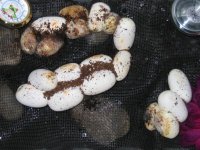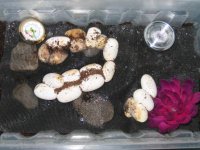daneale777
New member
So, I'm on day seven of incubation. Six looked to be slugs from the beginning, but these are my first eggs ever, so I thought I'd wait. Now seven look to have mold on them. The one on the bottom right has one attached underneath that always looked like a possible slug to me, but now it is getting the okay looking egg moldy. The "okay" egg always looked to have a thinner area on that side, but okay.
Like I stated this is my first mating and first clutch, so I'm freaking out a bit. They are on a screen, on moss in a home made (heated water on the bottom aquarium, on bricks, in tupperware, with air holes.) The temp is consistent at between 80-83 degrees (by probe). I have two humidity gauges in with them. One reads 70; the other 90. Ninety seems more accurate to me.
What can/ should I do at this point?
Thanks everyone!!!!
Like I stated this is my first mating and first clutch, so I'm freaking out a bit. They are on a screen, on moss in a home made (heated water on the bottom aquarium, on bricks, in tupperware, with air holes.) The temp is consistent at between 80-83 degrees (by probe). I have two humidity gauges in with them. One reads 70; the other 90. Ninety seems more accurate to me.
What can/ should I do at this point?
Thanks everyone!!!!



